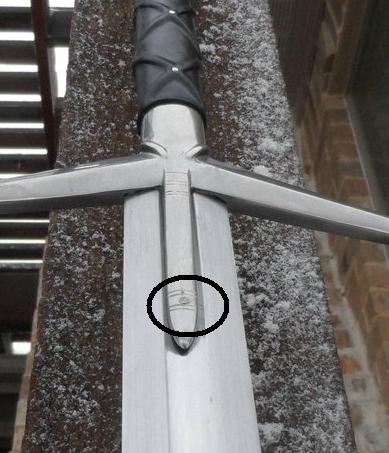| Author |
Message |
Chad Arnow
myArmoury Team


|
 Posted: Mon 08 Apr, 2013 5:16 pm Post subject: Peened langets/blade on a Hanwei Claymore Posted: Mon 08 Apr, 2013 5:16 pm Post subject: Peened langets/blade on a Hanwei Claymore |
 |
|
I've mentioned in the past that I've seen and held a Hanwei Claymore on which the langets were riveted through the blade. Some of my mentions have been met with, shall we say, skepticism. 
I foudn a pic in this For Sale thread that may help corroborate what I saw.

I know some have seen these without this feature, but I have beheld it with my own eyes. This one appears to have the same thing.
Interesting feature. I've always wondered why they did that on at least the one I saw. 
 Attachment: 35.1 KB Attachment: 35.1 KB

The rivet head has been circled. It's clearly not cast in.

ChadA
http://chadarnow.com/
|
|
    |
 |
Glen A Cleeton

|
|
  |
 |
Jesse Belsky
Industry Professional

|
 Posted: Mon 08 Apr, 2013 9:02 pm Post subject: Posted: Mon 08 Apr, 2013 9:02 pm Post subject: |
 |
|
|
This is purely speculative, but perhaps the rivet keeps the langet tight to the fuller, as it appears to be in this and the KOA pics. Otherwise you'd have a gap, because the langet would run straight up the blade at the width of the tang thickness. They might object to that visual gap, or it might cause a rattle when the blade flexed.
|
|
   |
 |
|
Matthew P. Adams
|
 Posted: Mon 08 Apr, 2013 10:05 pm Post subject: Posted: Mon 08 Apr, 2013 10:05 pm Post subject: |
 |
|
Did the langet serve any purpose other than decorative? Where they blade traps?
"We do not rise to the level of our expectations. We fall to the level of our training" Archilochus, Greek Soldier, Poet, c. 650 BC
|
|
  |
 |
Chad Arnow
myArmoury Team


|
 Posted: Tue 09 Apr, 2013 6:27 am Post subject: Posted: Tue 09 Apr, 2013 6:27 am Post subject: |
 |
|
| Jesse Belsky wrote: | | This is purely speculative, but perhaps the rivet keeps the langet tight to the fuller, as it appears to be in this and the KOA pics. Otherwise you'd have a gap, because the langet would run straight up the blade at the width of the tang thickness. They might object to that visual gap, or it might cause a rattle when the blade flexed. |
I'd thought of those reasons. I'm sure they have some reason in their heads why they needed to put that in there, but they seem to be solving a problem that either didn't exist historical or wasn't considered a problem. So it makes me wonder why.
Has anyone seen that feature on a historical sword of this style? Or, how tightly did langets usually fit on these?

ChadA
http://chadarnow.com/
|
|
    |
 |
William Swiger

|
 Posted: Tue 09 Apr, 2013 8:44 am Post subject: Posted: Tue 09 Apr, 2013 8:44 am Post subject: |
 |
|
Had to head to the "man cave" and check mine. Has the rivet. 
|
|
  |
 |
|
Mark Moore
|
 Posted: Tue 09 Apr, 2013 11:25 am Post subject: Posted: Tue 09 Apr, 2013 11:25 am Post subject: |
 |
|
|
Chad, the Hanwei claymore has, I believe, had this rivet feature for quite a while now. Mine has it, and I personally like it as a structural feature. It keeps the langets tight to the blade, and no doubt reduces stress on the tang during cutting. I cant help but think that without it, one would get a 'tink-tink' sound with every side to side movement of the long blade. I've seen other claymores in the past, mainly the early Kris Cutlery model, that had the langets extending over the scabbard that came with the sword. To the best of my recollection, claymores were not held in scabbards, but just held over-shoulder or tied to horse or cart. I can't really see a function of the langets, other than to stabilize the blade. I doubt any historic examples have this feature, but I could be wrong...........McM
|
|
  |
 |
|
Mark Moore
|
 Posted: Tue 09 Apr, 2013 11:28 am Post subject: Posted: Tue 09 Apr, 2013 11:28 am Post subject: |
 |
|
|
By that last statement, I mean the rivet...not the langets............McM
|
|
  |
 |
|
Peter Lyon
Industry Professional
|
 Posted: Tue 09 Apr, 2013 11:40 am Post subject: Posted: Tue 09 Apr, 2013 11:40 am Post subject: |
 |
|
That Hanwei sword is very similar to "E.1939.65.HT Claymore 16-17c" held at Kelvingrove (which I got to handle in 2008), which has langets that long, fitting close to the blade. If you look at the early 15th century proto-claymores (longswords with spatulate ends to the cross and a small point in the centre of the cross) you can see where this evolved from, but I suspect that by the 16th/17th century they were purely decorative as I can't see a purpose for them. And no, it doesn't have a rivet through the blade.
Still hammering away
|
|
  |
 |
|
|

